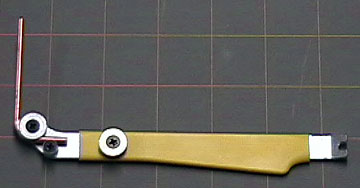Assembling the Fuel Tank
Note: Information contained in the instructions supersedes information presented here.
Before assembling the fuel tank, be sure to review the instructions that came with
it.
It is not difficult to assemble a fuel tank but if it is not
assembled properly you can expect a great deal of
frustration at the field.
All R/C fuel tanks assemble in a similar
manner and these basic philosophies apply to all tanks:
-
Always deburr metal fittings to prevent cuts in the
silicone fuel line.
-
Always set up the feed line
inside the tank so that it is approximately 1/4" from the rear of the
tank. Hold the tank vertically so that it is back-lit to help
you see inside of it.
The feed line should hang straight down. If it clears
the back of the tank by 1/4" then it will be slightly farther away when it is resting on the top
or bottom of the tank. This prevents the fuel from surging into the
line and flooding the engine when throttle is applied (so I'm told).
-
Always disassemble a tank after initial assembly
and wash the tank and fittings out thoroughly to remove metal shavings and other crud. Be
sure to run water through the brass tubing and pick-up line. If you
have an air compressor then blowing some pressurized air into the tank
(without the stopper assembly in place) and through the feed lines will help
remove any particles.
-
There is normally a third hole in the stopper
that is plugged. Don't open this hole unless you plan to use a
three-line fuel system.
Fuel tanks come with brass or aluminum tubes.
The feed line should only extend in to the tank about 1/2". That gives plenty
of tube for the fuel line to grip. If the metal tube is inserted too
far into the tank then it will
inhibit free movement of the feed line.
The vent line should be slowly bent to 90°. I generally make the bend
far enough from the end of the tube so that it is too long. Then I cut
off the excess so that the vent clears the top of the tank by 1/16" to 1/8".
You can either buy a tubing bender or use a variety of methods to keep the
tubing from collapsing when you bend it. Some people fill the tube
with sand or feed a weed-eater line into it while bending.
 I
purchased a tubing bender in Germany that works well. The
tube must be pulled while bending to prevent it from collapsing. Soft
tubing can be bent around your thumb if you bend the tubing slowly. The
tube does collapse slightly, but it still passes fuel easily. I
purchased a tubing bender in Germany that works well. The
tube must be pulled while bending to prevent it from collapsing. Soft
tubing can be bent around your thumb if you bend the tubing slowly. The
tube does collapse slightly, but it still passes fuel easily.
Do Not use a
razor saw to cut metal tubing (unless you don't mind ruining the saw).
The two easiest ways to cut the metal tubes is
with a small tubing cutter (K & S) or a
moto-tool with a
cut-off wheel.
To deburr the tubes, turn a counter-sink by hand in the end. The idea
here is to remove the burr inside the tube - not to sharpen the tube.
Use
very fine sandpaper around the outside.
What I normally do is put a cut-off
wheel in my moto tool and then spin the tube at about a 45°
angle against the wheel. Check your work carefully because it
only takes a small cut in the fuel line to make your engine run erratically
and make you pull your hair out.
Fuel Tank Stopper Assembly

This is how a stopper assembly should look
when it is assembled. The feed line made of fuel tubing is flexible.
The clunk on the end of the line is heavy
and
ensures that the pick-up is always submerged in fuel.
|
The feed lines should extend about 1/2" from the front of the tank as well.
If the lines do not route in a fairly straight line from the tank through
the firewall, then you may need to
bend the metal tubes in the general direction of the exits on the
firewall. This will
help prevent the fuel lines from kinking in the tank compartment.
The fuel tank is sealed through the use of a
rubber stopper. On the front and back of the stopper are hard plastic
or metal plates. The metal tubes pass through the plates and the
stopper.
A screw goes through the center of the front plate and
stopper and threads into the back plate. When the screw is tightened,
the stopper compresses and expands sealing the tubes and the front of the tank.
You will notice that there is a third hole in most
stoppers that is plugged. Do not use this hole or open it unless you
plan to make a three-line tank. It is easiest to slide the tubes
through the stopper if you spit into the stopper holes first.
A common mistake you can make when assembling
the tank is to over-tighten the stopper bolt. The stopper is
sealed when it bulges and it will not come loose. Just because you can turn the brass
tubes in the stopper holes does not mean they are not sealed. If you over-tighten the stopper it is
very likely that the tank will split and spill fuel all over the inside of
your aircraft.
Testing the Tank for Leaks
Put a fuel line on the vent and another line on the feed. Plug one
line, put the tank under water and blow in the open tube. If you see
air bubbles coming from anywhere in the tank it is not sealed properly.
|
![]()